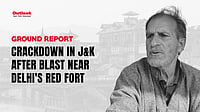The smoky haze shrouding Delhi thickened on Thursday, obscuring the skyline and hiding the sun, due to a surge in farm fires and unfavourable weather conditions, prompting doctors to issue warnings about breathing issues being aggravated.
Scientists have warned of a spike in pollution levels in Delhi-NCR over the next two weeks. This is concerning as the Air Quality Index (AQI) in many areas has already breached the 400-mark to enter the severe category.
An official from the India Meteorological Department reported that visibility reduced to just 500 metres at the Safdarjung Observatory around 7 am, gradually improving to 800 metres as temperatures increased during the day.
Cold temperatures create stable atmospheric conditions, known as temperature inversions, where a layer of warm air traps cooler air near the ground, allowing the accumulation of pollutants.
At 3 pm, the city's AQI reached 378. The 24-hour average AQI was 364 on Wednesday, 359 on Tuesday, 347 on Monday, 325 on Sunday, 304 on Saturday, and 261 on Friday.
Several areas within the city, including Punjabi Bagh (439), Dwarka Sector-8 (420), Jahangirpuri (403), Rohini (422), Narela (422), Wazirpur (406), Bawana (432), Mundka (439), Anand Vihar (452) and New Moti Bagh (406), recorded 'severe' air quality.
An AQI between zero and 50 is considered 'good', 51 and 100 'satisfactory', 101 and 200 'moderate', 201 and 300 'poor', 301 and 400 'very poor', and 401 and 500 'severe'.
The concentration of PM2.5, fine particulate matter that can penetrate deep into the respiratory system and trigger respiratory problems, exceeded the safe limit of 60 microgramme per cubic metre by six to seven times in these areas.
Health professionals have expressed concerns that air pollution is increasing asthma and lung problems in children and the elderly.
"We are recording a surge in the number of irritative bronchitis infections. It is recommended that people suffering from respiratory issues such as chronic bronchitis and asthma take their medicines regularly and do not go out in the open unless absolutely necessary," said Jugal Kishore, the head of the medicine department at Safdarjung Hospital.
Considering the spike in indoor pollution in Delhi, he advised people to use air purifiers in their homes.
One of the major reasons behind the accumulation of pollutants in recent days is the lack of rainfall during this post-monsoon season so far.
According to government data, Delhi's air quality in October 2023 was the worst since 2020, with meteorologists attributing it to the absence of rainfall. The capital recorded an AQI of 210 in October, compared to 210 in October last year and 173 in October 2021, according to the Central Pollution Control Board (CPCB).
In contrast to October 2022 (129 mm) and October 2021 (123 mm), Delhi experienced only one rainy day (5.4 mm of precipitation) in October 2023.
Unfavourable meteorological conditions, combined with emissions from firecrackers, paddy straw burning, and local pollution sources, contribute to hazardous air quality levels in Delhi-NCR during winter.
According to an analysis conducted by the Delhi Pollution Control Committee (DPCC), the capital experiences peak pollution from November 1 to November 15 when the number of stubble burning incidents in Punjab and Haryana increase.
The Commission for Air Quality Management (CAQM), a statutory body responsible for formulating strategies to reduce pollution in Delhi-NCR, reported that the number of stubble burning incidents in Punjab and Haryana since September 15 has reduced by around 56 per cent and 40 per cent, respectively, compared to the corresponding period last year.
The Punjab government aims to reduce farm fires by 50 per cent in this winter season and eliminate stubble burning in six districts.
According to Punjab's action plan to curb paddy straw burning, about 31 lakh hectares of land in the state are under paddy cultivation, expected to generate around 16 million tonnes of paddy straw (non-basmati).
Haryana estimates that about 14.82 lakh hectares of land in the state are under paddy cultivation, expected to generate over 7.3 million tonnes of paddy straw (non-basmati).
The state is making efforts to nearly eliminate farm fires this year.
According to a numerical model-based system developed by the Indian Institute of Tropical Meteorology (IITM) in Pune, vehicular emissions (11 per cent to 16 per cent) and stubble burning (seven per cent to 16 per cent) currently stand as the two major contributors to Delhi's air quality.
Delhi Environment Minister Gopal Rai announced on Wednesday that the city government would ban construction work in areas where the AQI remains above the 400-mark for five consecutive days.
The Delhi government launched a 15-point action plan last month to mitigate air pollution during the winter season, with a strong emphasis on addressing dust pollution, vehicular emissions, and open burning of garbage.
In line with the practice of the last three years, the Delhi government last month also announced a comprehensive ban on the manufacture, storage, sale, and use of firecrackers within the city.
It has launched "Red Light on Gaadi Off" campaign to curb vehicular pollution and plans to hire 1,000 private CNG buses to strengthen public transport and reduce vehicular pollution.
Air pollution in India resulted in 1.67 million deaths in 2019 -- the largest pollution-related death toll in any country in the world -- and accounted for USD 36.8 billion in economic losses, according to a new study by researchers from the Global Observatory on Pollution and Health at Boston College, the Indian Council of Medical Research, and the Public Health Foundation of India.


























